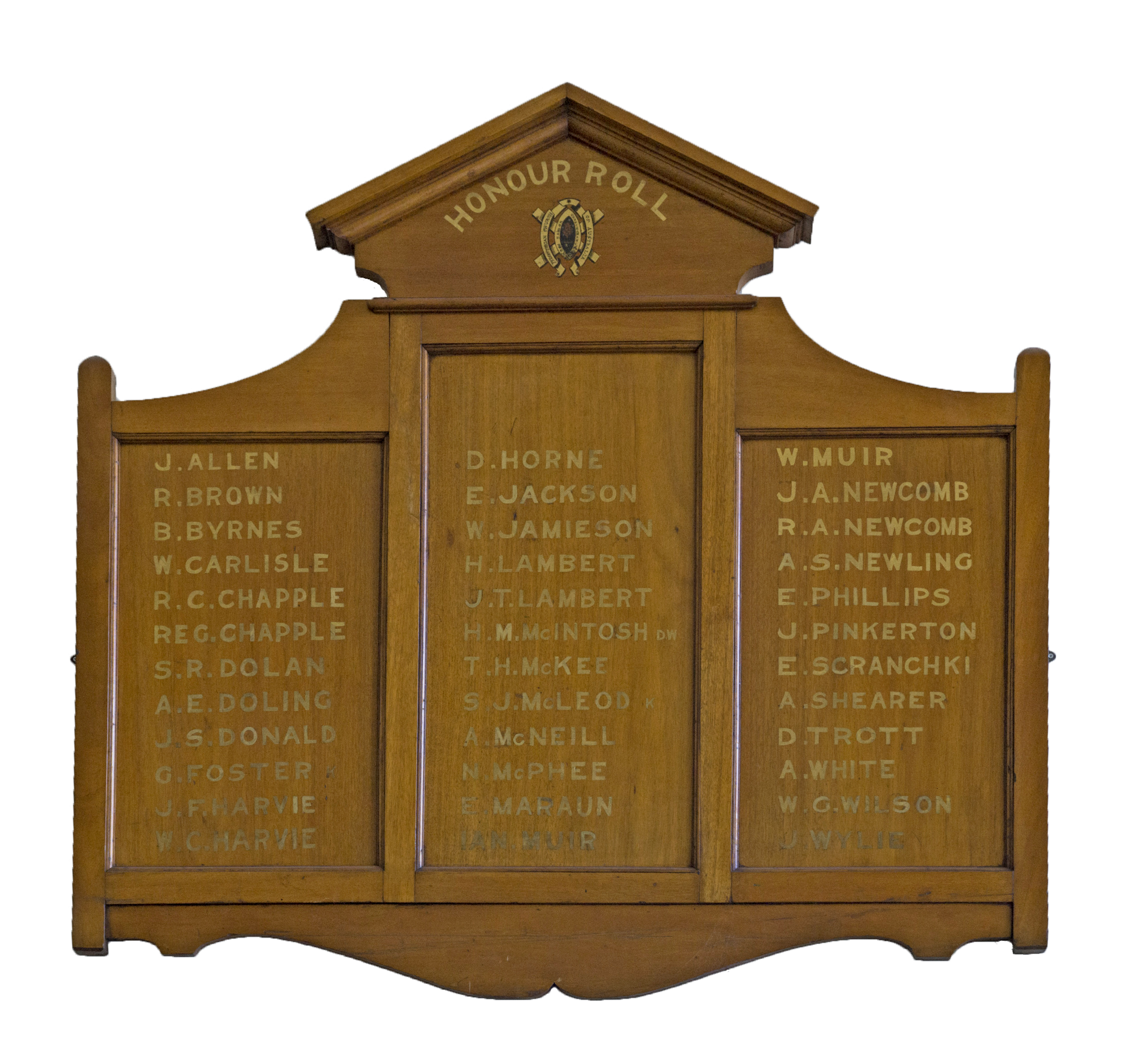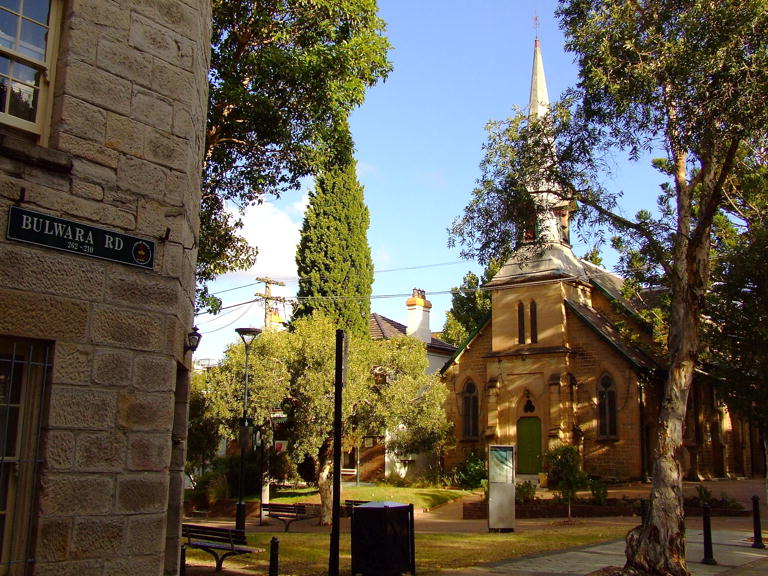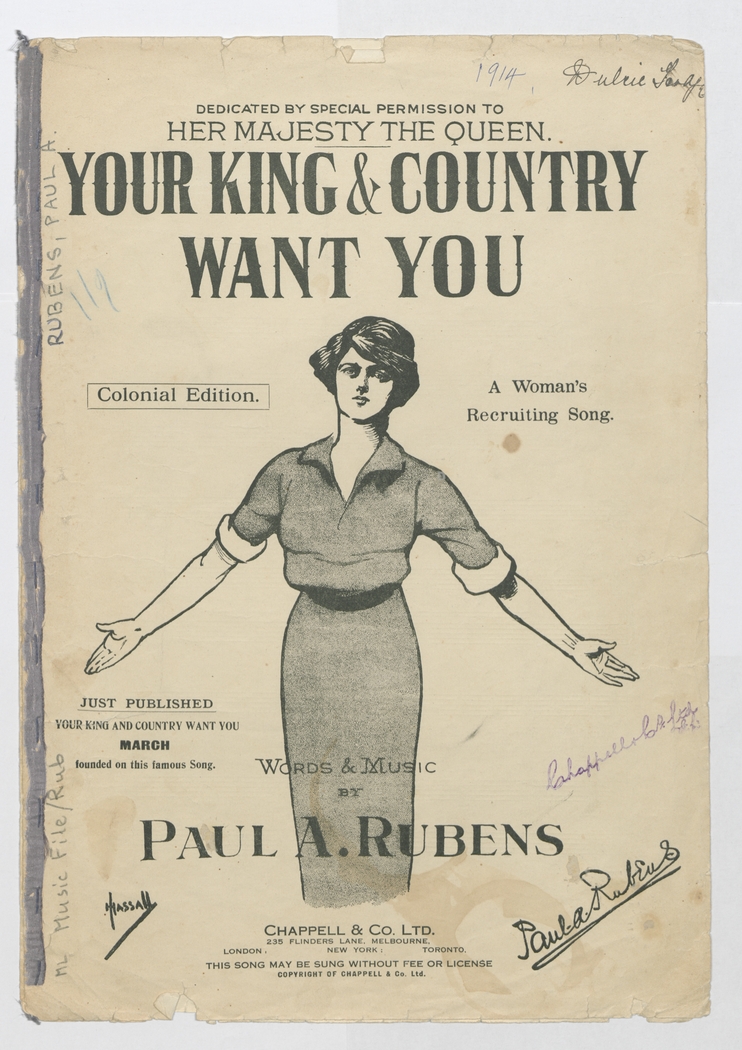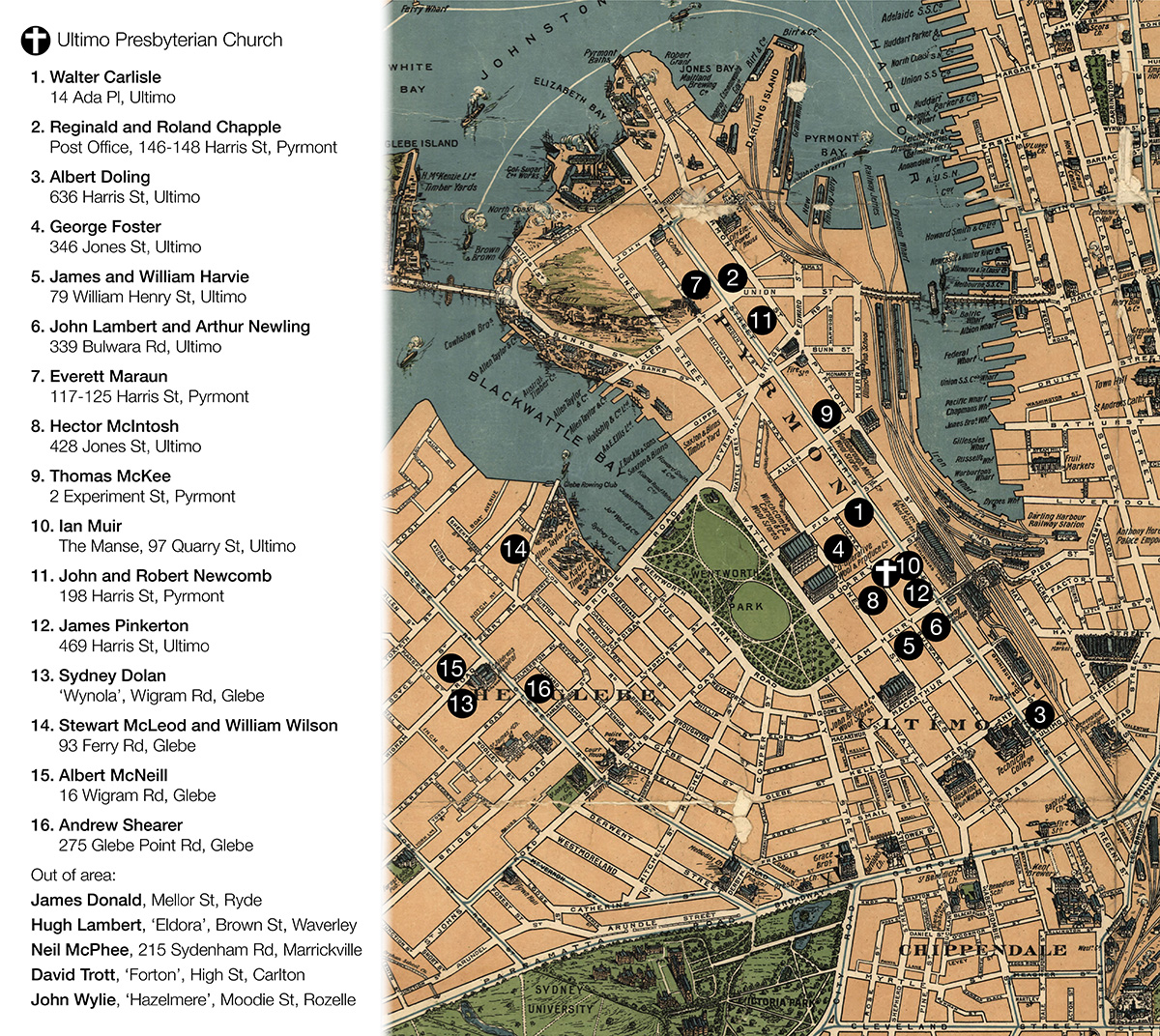The Dictionary of Sydney was archived in 2021.
Ultimo Presbyterian Church Roll of Honour
Citation
Persistent URL for this entry
To cite this entry in text
To cite this entry in a Wikipedia footnote citation
To cite this entry as a Wikipedia External link
Ultimo Presbyterian Church Roll of Honour
Several years ago, in a small attic of the former Ultimo Presbyterian Church, a handyman stumbled across a three-panelled wooden World War I honour board. Its [media]gold lettering still glistened in the shadows with the names of men long gone, almost a century after the board's creation. According to one former churchgoer, no one knew how long it had lain in the attic but a deaconess who was at the manse during the 1940s had no memory of seeing it installed in the church.
[media]The Ultimo Presbyterian Church Roll of Honour is currently housed in the foyer of the Ultimo Community Centre. While there are many stories about the movement of the honour roll that remain unknown, the stories behind the 36 names on the board are a poignant insight into the lives of the men who enlisted in the Australian Imperial Force (AIF) and the effects of the World War I on the Ultimo community.
Servers and shirkers
Is your name there upon the honour board enscrolled,
That, in the years to come, may mutely there be told
How you, with honour crowned, went out, for Right to stand,
Fared forth to seek the foe, with Glory hand in hand?
Is your name there? If not, search deep within your soul,
Rest not till it be writ upon the shining scroll,
Though strength, wealth, love be yours they will be linked with shame
Till end your days unless is written there your name. [1]
Within a few months of Australia joining Britain in declaring war on 4 August 1914, newspapers and community leaders began discussing the merits of rolls of honour and, within a short period, they became one of the most common forms of commemoration. Soon honour boards were put up in buildings across the country including schools, churches, workplaces, sporting clubs and town halls. [2] Created as 'unfinished, interim artefacts', they were designed to be added to over the course of the war, becoming a tangible representation of the sacrifice made by the men of each community. [3] When casualties mounted on the battlefields and soldiers fell, memorials and rolls of honour also became sites where, in the absence of a physical grave, relatives could see the names of their loved ones and pay their respects. [4]
Honour rolls and recruiting
As the war waged on, the number of men enlisting dwindled, provoking debates about conscription. The honour roll took on a new purpose, becoming a recruitment device. The lists of names on honour boards ostensibly divided the 'shirkers', who avoided service, from the 'servers' who signed up. Public, private and religious bodies felt that listing and celebrating the names of those willing to volunteer would bolster enthusiasm for the war and aid recruitment. Councils hosted elaborate unveilings featuring musical bands, parades and stirring speeches. [5] Honour rolls became what Ken Inglis has termed 'scoreboards of commitment', reflecting the scope of each community's contribution to the war effort. [6]
From early in the war, religious leaders were vocal in advocating honour rolls. When the Catholic Primate of All Ireland, Archbishop John Baptist Crozier, visited Sydney in January 1915, he was quoted as saying 'there was no way so potent for encouraging a spirit of brotherhood' than that of the roll of honour. [7] Crozier thought that such a list should be installed in every parish and that those on the battlefront would derive 'joy' in the knowledge that they had not been forgotten and would be 'remembered by name'. [8] The Anglican Bishop of Bathurst, George Long, compared the 'shirkers' to the 'Kaiser's Armies', saying that the honour roll would serve to remind parishioners of their duty, that if 'they have a spark of manliness left, perchance they may blush with shame to know their names are not there'. [9]
Others, such as author Bertha Phelps, were concerned by this mentality. Shortly after Long's comments were published, she wrote to The Sydney Morning Herald to say that while honour rolls would encourage enlistment it would be wrong if they were used to expose those whose names were not on the list: 'They do not need to be lashed into it with whips of scorn.' [10] Yet Phelps' views on the honour roll appear to have been part of a minority. Certainly the Scottish-born minister of the Ultimo Presbyterian Church, Reverend John Muir, mirrored the views of his religious contemporaries. He was closely involved in the installation of honour rolls in St Andrew's Presbyterian Church in Nowra and the Ultimo Presbyterian Church. [11]
Reverend Muir at Nowra
Reverend John Muir was inducted into the Ultimo Presbyterian Church in January 1916 after serving eight years at St Andrew's Presbyterian Church in Nowra. [12] Muir had demonstrated his support for the war on a number of occasions at Nowra. On 29 August 1914, just over three weeks after war was declared, he addressed a patriotic meeting at the Nowra School of Arts about Australia's 'duty to assist the mother country and her allies' and contributed to their newly created patriotic fund. [13] Muir conducted memorial services for men in the community who had been killed and made speeches to departing soldiers in services packed full of parishioners. [14] In one address, he offered the following words of counsel:
My dear young friends…Remember, that the honor of the nation and of your Church is to a large extent in your hands, and resolve, God helping you, to be true to your sacred trust. [15]
In another, he told his parishioners that 'unless we are helping to the full extent of our power and opportunity we are unworthy the name of patriots' and that although many men had enlisted, 'there is room in the ranks for many more'. [16] In September 1915 Muir supported a council motion to erect a 'temporary memorial, which might be placed in some conspicuous public position, thus acting as an incentive for further enlistment'. [17] The following month, he attended a meeting of the Nowra Recruiting Association and was part of the committee supporting a 'South Coast route march' to gather recruits. [18]
St Andrew's Nowra Honour Roll
On 2 January 1916, when Muir gave his last Sunday morning service at St Andrew's Nowra, he concluded by addressing the large congregation. The Shoalhaven Telegraph reported Muir:
…made a touching reference to the spirit of self sacrifice of the young men who had voluntarily offered themselves at the call of King, country, and conscience.
He also touched upon the noble heroism of the mothers who had cheerfully given their sons to fight for the religious, civil, and social rights and privileges that we enjoyed as a people as a heritage.
Mrs Muir [media]then unveiled a honour roll, made of British oak and featuring 22 names, including that of his own son. [19] A few days later at Muir's farewell the congregation toasted the Reverend and Mrs Muir and presented them with gifts including a photographic album featuring men connected with the church who had 'responded to the call of Empire'. [20] Muir voiced his gratitude, stating he valued the album as a:
…memento of the brave young men who had gone from that church to the Front, and whose bravery had been lastingly recorded on the honor roll recently placed on the walls of their place of worship. [21]
The reverend's parting words invoked enlistment for the war effort as he quoted the popular recruiting song by Paul Rubens, 'Your King and Country Want You' (1914), by telling his parishioners 'he did not want to lose them, but he thought he ought to go.' [22]
The Ultimo honour roll
The Ultimo Presbyterian Church Roll of Honour was unveiled on the afternoon of 30 July 1916. Muir may have urged the congregation to follow Nowra's lead – the roll of honour at Ultimo lists Ian Miller Muir, who had already enlisted at Nowra, and his is the only name on the roll spelled out in full. [23] At the time of the roll's unveiling it contained 19 names; [24] it would come to bear 36.
Reverend Muir's patriotic stance on the war continued well beyond the cessation of hostilities. He is recorded at Narromine in 1924 'delivering an impressive address' at the unveiling of a soldiers' memorial there for those who made 'the Supreme Sacrifice for their Country'. [25]
Finding out the stories behind the roll
[media]Professor Bruce Scates has talked about 'commemoration fatigue' and the obsessive, jingoistic focus on what happened on the shores of Gallipoli. [26] As Scates put it, these men were a 'war-wrecked generation' and their 'battles didn't end in 1918'. [27] The Ultimo Presbyterian Church Honour Board reveals some of these local stories and illuminates the broader conflict. An examination of the service records of the men on the honour roll, combined with newspaper and family history research, reveals some of the impact of the war on on soldiers, their families and the broader community.
Further reading
KS Inglis. Sacred Places: War Memorials in the Australian Landscape. 3rd ed. Melbourne: Melbourne University Press, 2008.
Bruce Scates. 'Annual History Lecture 2015 – Anzac Amnesia: How the Centenary Forgot the War'. 8 September 2015. History Council of New South Wales. http://www.historycouncilnsw.org.au/history/post/annual-history-lecture-2015-anzac-amnesia-how-the-centenary-forgot-the-war/
Notes
[1] Edith E Reddall, 'The Honour Roll,' Sydney Mail, 10 July 1918, 32, http://nla.gov.au/nla.news-article160628623, viewed 20 September 2015
[2] KS Inglis, Sacred Places: War Memorials in the Australian Landscape, 3rd ed (Melbourne: Melbourne University Press, 2008), 101–102
[3] KS Inglis, Sacred Places: War Memorials in the Australian Landscape, 3rd ed (Melbourne: Melbourne University Press, 2008), 102
[4] Neil Radford, 'War Memorials for World War I,' Dictionary of Sydney, 2014, http://dictionaryofsydney.org/entry/war_memorials_for_world_war_i, viewed 8 October 2015
[5] KS Inglis, Sacred Places: War Memorials in the Australian Landscape, 3rd ed (Melbourne: Melbourne University Press, 2008), 103–105
[6] KS Inglis, Sacred Places: War Memorials in the Australian Landscape, 3rd ed (Melbourne: Melbourne University Press, 2008), 102
[7] 'A red vineyard of war,' Watchman, 28 January 1915, 2, http://nla.gov.au/nla.news-article111804426, viewed 20 September 2015
[8] 'A red vineyard of war,' Watchman, 28 January 1915, 2, http://nla.gov.au/nla.news-article111804426, viewed 20 September 2015
[9] 'Servers and shirkers,' Clarence and Richmond Examiner, 9 January 1915, 11, http://nla.gov.au/nla.news-article61645441, viewed 20 September 2015
[10] 'The call to manhood,' The Sydney Morning Herald, 20 January 1915, 12, http://nla.gov.au/nla.news-article15567952, viewed 20 September 2015
[11] 'Memorial to District Soldiers,' The Shoalhaven Telegraph, 1 September 1915, 8, http://nla.gov.au/nla.news-article127432008, viewed 20 October 2015
[12] 'Send-off to Mr and Mrs Muir,' The Shoalhaven Telegraph, 26 January 1916, 10, http://nla.gov.au/nla.news-article127435493 and 'The Churches,' The Sydney Morning Herald, 23 November 1907, 10, http://nla.gov.au/nla.news-article14875779, viewed 20 September 2015
[13] 'Patriotic Meeting. Nowra Subscriptions,' The Shoalhaven News and South Coast Districts Advertiser, 29 August 1914, 4, http://nla.gov.au/nla.news-article112549394, viewed 20 September 2015
[14] 'Sid Watt Killed,' The Shoalhaven News and South Coast Districts Advertiser, 26 June 1915, 2, http://nla.gov.au/nla.news-article112549641 and 'Church Parade,' The Shoalhaven Telegraph, 4 August 1915, 6, http://nla.gov.au/nla.news-article127434150, viewed 20 September 2015
[15] 'Sid Watt Killed,' The Shoalhaven News and South Coast Districts Advertiser, 26 June 1915, 2, http://nla.gov.au/nla.news-article112549641 and 'Church Parade,' The Shoalhaven Telegraph, 4 August 1915, 6, http://nla.gov.au/nla.news-article127434150, viewed 20 September 2015
[16] 'Church Parade,' The Shoalhaven Telegraph, 4 August 1915, 6, http://nla.gov.au/nla.news-article127434150, viewed 20 September 2015
[17] 'Memorial to District Soldiers,' The Shoalhaven Telegraph, 1 September 1915, 8, http://nla.gov.au/nla.news-article127432008, viewed 20 September 2015
[18] 'Recruiting Campaign,' The Shoalhaven Telegraph, 27 October 1915, 6, http://nla.gov.au/nla.news-article127434336, viewed 20 September 2015
[19] 'Presbyterian Church Honor Roll,' The Shoalhaven Telegraph, 5 January 1916, 1, http://nla.gov.au/nla.news-article127435871, viewed 20 September 2015
[20] 'Send off and Presentation to Rev Mr and Mrs Muir,' The Shoalhaven News and South Coast Districts Advertiser, 29 January 1916, 4, http://nla.gov.au/nla.news-article112541188, viewed 20 September 2015
[21] 'Send off and Presentation to Rev Mr and Mrs Muir,' The Shoalhaven News and South Coast Districts Advertiser, 29 January 1916, 4, http://nla.gov.au/nla.news-article112541188, viewed 20 September 2015
[22] 'Send off and Presentation to Rev. Mr. and Mrs. Muir,' The Shoalhaven News and South Coast Districts Advertiser, 29 January 1916, 4, http://nla.gov.au/nla.news-article112541188, viewed 20 September 2015
[23] 'Send off and Presentation to Rev. Mr. and Mrs. Muir,' The Shoalhaven News and South Coast Districts Advertiser, 29 January 1916, 4, http://nla.gov.au/nla.news-article112541188, viewed 20 September 2015
[24] 'Presbyterian,' Newcastle Morning Herald and Miners' Advocate, 29 July 1916, 12, http://nla.gov.au/nla.news-article133885279, viewed 20 September 2015
[25] 'Narromine's Tribute. Unveiling Of Soldiers' Memorial,' The Dubbo Liberal and Macquarie Advocate, 29 April 1924, 2, http://nla.gov.au/nla.news-article78989402, viewed 20 September 2015
[26] John Donegan, 'Monash chair of History and Australian Studies slams 'spectacle' of World War One commemorations,' ABC News, 11 September 2015, http://www.abc.net.au/news/2015-09-11/historian-slams-misguided-world-war-one-commemorations/6768172, viewed 30 September 2015
[27] Bruce Scates, 'Annual History Lecture 2015 – Anzac Amnesia: How the Centenary Forgot the War,' 8 September 2015, History Council of New South Wales, http://www.historycouncilnsw.org.au/history/post/annual-history-lecture-2015-anzac-amnesia-how-the-centenary-forgot-the-war/, viewed 30 September 2015






